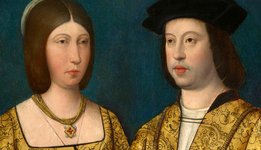Ferdinand and Isabella: The Marriage That Unified Spain | TheCollector
thecollector.com
Ferdinand and Isabella: The Marriage That Unified Spain | TheCollector

Isabella, born in 1451, was initially seen by her father, John II of Castile, as a tool to expand Castilian territory and unite Spain. She faced multiple betrothals, including to a Portuguese King Afonso V of Portugal and a member of the Castilian court Pedro Girón Acuña Pacheco, but eventually, her uncle King Henry IV named her as his heir and allowed her to choose her own marriage. This empowered Isabella to pursue a union with Ferdinand of Aragon on her own terms.
the dynastic union was formed through what happened in this paragraph
dynastic union. what is this? i keep hearing it